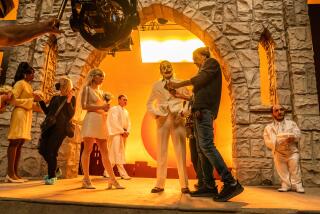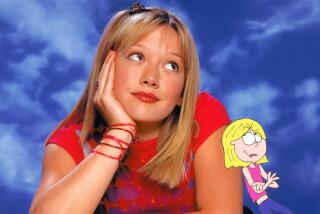Another splashy event for the kids
- Share via
THE high school environment may be missing from “High School Musical 2,” but just about every other element of Disney’s blockbuster 2006 telefilm is back in the sequel, with every Wildcat feverishly pent up in the opening scene, counting the seconds until school is out -- and the dancing begins.
Begin it does, again choreographed by Kenny Ortega (also returning as director), Charles Klapow and Bonnie Story in the same muscular, semaphoric style as in the first film. More influenced by stepping than hip-hop, that style is ideally suited to the dance-as-sport ideas that continue to fuel the sequel’s full-scale production numbers (baseball this time, as well as basketball).
Very much to the point, the dancing also always looks like something that any teen could do -- especially when the hero’s official Best Friend declares in song “I Don’t Dance,” and the villainess’ turncoat Little Brother proves otherwise. And although camera angles switch with great rapidity, the shot-to-shot continuity of the dancing is kept intact in nearly every sequence.
That’s important. For far too long now, film and television dance has been ruled by the MTV dictate of sell the music, dump the dancing. The result has been that only pop singers who also dance (Michael Jackson, for starters) or films with directors who are also choreographers (“Chicago,” for example, or more recently “Step Up,” a different kind of high school musical) allow the dancing to make its effect.
Directors who hire choreographers (as in “Take the Lead, “ “Dreamgirls” and most music-video projects) generally leave the dancing in tatters, and audiences have come to accept that this is the reality for media-dance, all that the contemporary youth audience will accept.
The tide turned with the enormous international success of the original “High School Musical” and, indeed, Disney even telecast a version of the film fitted out with extra sequences in which the members of the cast taught the steps of two ensemble numbers to the TV audience, breaking down the choreography and running it at half-speed so that everyone could dance along.
Ortega & Co. may not be Balanchine or Cunningham, but anyone who makes young people feel that dance is fun to watch and to do is on the side of the angels, along with such hit reality series as “Dancing With the Stars” and “So You Think You Can Dance.”
Concert dance may be utterly absent from American network TV and most cable schedules, but these pop and ballroom shows create an appetite and develop an audience that may well want to move on to something deeper and more complex after a while. So stay tuned. The future just could be -- as the deliciously Machiavellian Sharpay sings in “High School Musical 2” -- fabulous.
--
Segal is The Times’ dance critic.
More to Read
Only good movies
Get the Indie Focus newsletter, Mark Olsen's weekly guide to the world of cinema.
You may occasionally receive promotional content from the Los Angeles Times.










